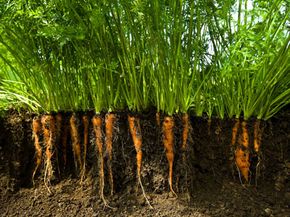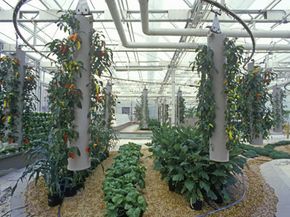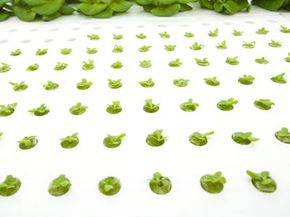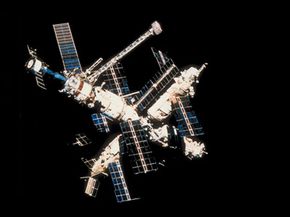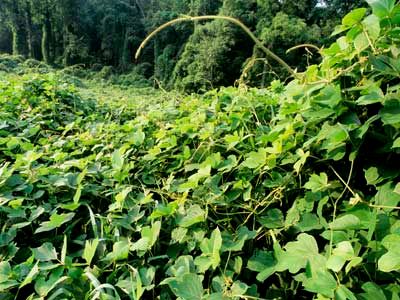Imagine a board with holes drilled equidistantly apart and plugged with a stabilizer like foam rubber. After plants germinate from seed in a soilless medium like Rockwool, (a fibrous material woven from strands of lava) they're transplanted to the board. As the plant grows, the upper parts of the plant (the crown) grow above the board, while the roots are left to dangle below.
Beneath the board is an enclosed area known as the root chamber. This area's purpose is twofold: It protects the roots from light and it holds the nutrient/water solution that feeds them. A sump pump pushes the solution through a pipe and out of a series of nozzles that atomize the solution and spray a fine fog directly onto the roots. In an enclosed system, whatever doesn't get absorbed by the roots falls back down into the solution chamber and gets cycled through again. The pump is set to an automatic timer and delivers this high-powered nutrient solution at regular intervals.
A-frame aeroponic systems are also in wide use. Instead of horizontal boards, A-frame systems use tall cones made of PVC frames and enclosed with chicken wire and plastic. The interior serves as the root chamber. The plants' roots hang at a downward angle inside the cone, while the plants grow upward through the plastic on the side. (Think of a Chia Pet teepee.) A-frame systems have a decided advantage over horizontal systems in that they require less square footage for the same plant density, since the systems are arranged upward instead of outward.
This kind of thinking reflects the basic premise behind aeroponics -- using the minimum amount of input to gain the maximum output. The fact that it lacks soil is another important aspect. Soil provides plants with stability, warmth, and an easy way to distribute nutrients and water. But soil is also stingy, especially when it comes to allowing plants oxygen.
This may seem counterintuitive since the first thing you ever learned about plants is that they consume carbon dioxide and release oxygen. It's true that plants require carbon dioxide to convert sunlight into sugars through photosynthesis. But they also use oxygen to break those sugars down into useable forms of energy. More oxygen equals more plant growth, and plants receive more oxygen under aeroponic conditions, with their roots exposed to air and unencumbered by dense soil.
The way nutrients and water are delivered also demonstrates the efficiency of aeroponics. The nutrient solutions used on plants require only a little water. In enclosed systems, water use is even further diminished. Atomizing nozzles ensure the most effective delivery of nutrients, since they turn the water into a fine mist. Plants absorb nutrients through their roots by osmosis, a selective absorption of compounds through cell walls. Roots can absorb nutrients more easily as a result because they're delivered via the mist.
Aeroponics, you may have noticed by now, is plant growth on steroids. This is why it shouldn't surprise you that aeroponically grown plants tend to produce larger fruit crops and bigger roots. What's surprising is just how much more fruit a plant can yield.
